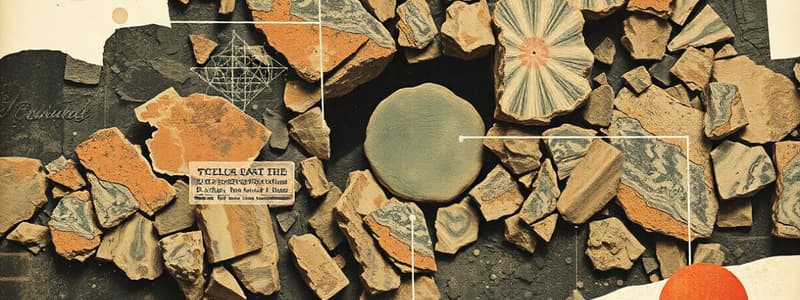Podcast
Questions and Answers
What primarily forms chemical or precipitated rocks?
What primarily forms chemical or precipitated rocks?
- Deposition from low-energy environments
- Sedimentation of organic materials
- Weathering of existing rocks
- Precipitation from a supersaturated solution (correct)
Which type of rock is formed through the metabolism of certain organisms?
Which type of rock is formed through the metabolism of certain organisms?
- Metamorphic rocks
- Igneous rocks
- Clastic rocks
- Biochemical rocks (correct)
Which of the following distinguishes ‘stratigraphic reefs’ from ‘ecological reefs’?
Which of the following distinguishes ‘stratigraphic reefs’ from ‘ecological reefs’?
- Composition of the carbonate materials
- The method of formation and environment (correct)
- Wave resistance
- The size of the organisms present
What characterizes boundstone within carbonate classification?
What characterizes boundstone within carbonate classification?
Ooids form in areas where water becomes supersaturated with respect to which substance?
Ooids form in areas where water becomes supersaturated with respect to which substance?
Which of the following best describes mudstone according to carbonate classification?
Which of the following best describes mudstone according to carbonate classification?
Where are oolitic sands typically formed?
Where are oolitic sands typically formed?
Chalks are primarily composed of what type of debris?
Chalks are primarily composed of what type of debris?
Study Notes
Chemical Rocks
- Form from precipitation of supersaturated solutions, primarily at the surface or in the upper crust
- Precipitation can be inorganic or biochemically driven by organisms
- Dominant types include carbonate and evaporite rocks
Carbonate Depositional Environments
- Tidal carbonates
- Bioturbation by burrowing organisms can disrupt original textures and structures
- Example: Callianassa shrimp mounds in the Bahamas
- Reefs and other organic buildups
- Wave-resistant structures are commonly referred to as reefs
- Non-wave-resistant structures are called banks or bioherms
- "Reef" has ambiguous meaning, so distinguish between "stratigraphic reefs" and "ecological reefs"
- Example: Large Tridacna bivalve in the Great Barrier Reef
- Oolites, carbonate banks, and shoals
- Form in high-energy, unstable environments like shelf edges
- Ooids can form when water becomes supersaturated with calcium carbonate
- Examples: Oolitic sand in Abu Dhabi, blackened ooid sands off Qatar
- Chalks
- Deeper-water carbonate sediment primarily composed of algal debris
- Famous example: Upper Cretaceous chalks of the Cliffs at Dover
Carbonate Classification after Dunham
- Boundstone
- Organically bound components during deposition
- Mudstone
- Mud-supported with less than 10% allochems
- Wackestone
- Mud-supported with more than 10% allochems
- Packstone
- Grain supported with carbonate mud
- Grainstone
- Grain supported without carbonate mud
Studying That Suits You
Use AI to generate personalized quizzes and flashcards to suit your learning preferences.
Related Documents
Description
Explore the fascinating world of chemical rocks and carbonate depositional environments in this quiz. Delve into the processes of precipitation and types of carbonate rocks, including tidal carbonates, reefs, and ooids. Challenge your knowledge on how organisms influence these geological formations and their classifications.



